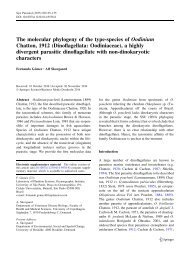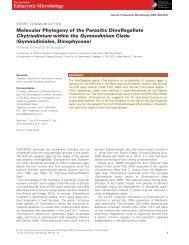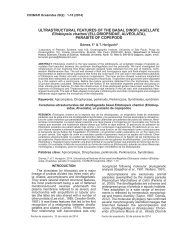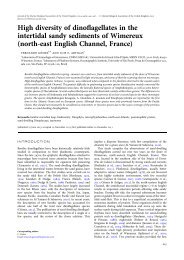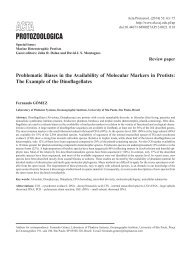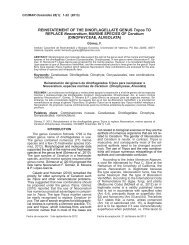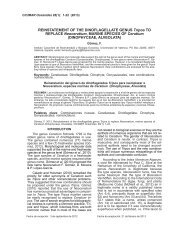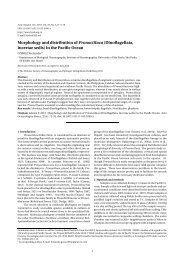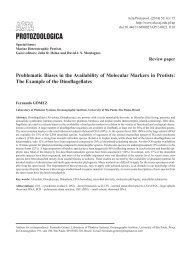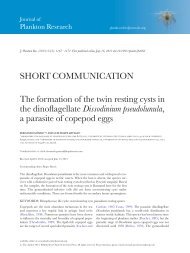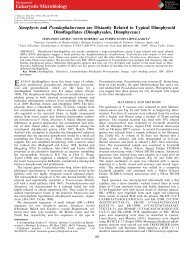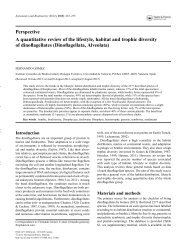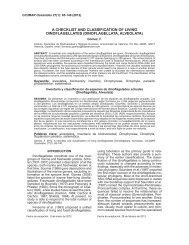Solenicola setigera is the first characterized memberof the abundant and cosmopolitan uncultured marine stramenopile group MAST-3
Culture-independent molecular methods based on the amplification, cloning and sequencing of smallsubunit (SSU) rRNA genes are a powerful tool to study the diversity of prokaryotic and eukaryotic microorganisms for which morphological features are not conspicuous. In recent years, molecular data from environmental surveys have revealed several clades of protists lacking cultured and/or described members. Among them are various clades of marine stramenopiles (heterokonts), which are thought to play an essential ecological role as grazers, being abundant and distributed in oceans worldwide. In this work, we show that Solenicola setigera, a distinctive widespread colonial marine protist, is a member of the environmental clade MArine STramenopile 3 (MAST-3). Solenicola is generally considered as a parasite or an epiphyte of the diatom Leptocylindrus mediterraneus. So far, the ultrastructural, morphological and ecological data available were insufficient to elucidate its phylogenetic position, even at the division or class level. We determined SSU rRNA gene sequences of S. setigera specimens sampled from different locations and seasons in the type locality, the Gulf of Lions, France. They were closely related, though not identical, which, together with morphological differences under electron microscopy, suggest the occurrence of several species. Solenicola sequences were well nested within the MAST-3 clade in phylogenetic trees. Since Solenicola is the first identified member of this abundant marine clade, we propose the name Solenicolida for the MAST-3 phylogenetic group.
Culture-independent molecular methods based on
the amplification, cloning and sequencing of smallsubunit
(SSU) rRNA genes are a powerful tool to
study the diversity of prokaryotic and eukaryotic
microorganisms for which morphological features are
not conspicuous. In recent years, molecular data from
environmental surveys have revealed several clades
of protists lacking cultured and/or described
members. Among them are various clades of marine
stramenopiles (heterokonts), which are thought to
play an essential ecological role as grazers, being
abundant and distributed in oceans worldwide. In this
work, we show that Solenicola setigera, a distinctive
widespread colonial marine protist, is a member of
the environmental clade MArine STramenopile 3
(MAST-3). Solenicola is generally considered as a
parasite or an epiphyte of the diatom Leptocylindrus
mediterraneus. So far, the ultrastructural, morphological
and ecological data available were insufficient
to elucidate its phylogenetic position, even at the division
or class level. We determined SSU rRNA gene
sequences of S. setigera specimens sampled from
different locations and seasons in the type locality,
the Gulf of Lions, France. They were closely related,
though not identical, which, together with morphological
differences under electron microscopy,
suggest the occurrence of several species. Solenicola
sequences were well nested within the MAST-3
clade in phylogenetic trees. Since Solenicola is the
first identified member of this abundant marine clade,
we propose the name Solenicolida for the MAST-3
phylogenetic group.
Create successful ePaper yourself
Turn your PDF publications into a flip-book with our unique Google optimized e-Paper software.
<strong>Solenicola</strong> belongs to <strong>uncultured</strong> <strong>stramenopile</strong>s <strong>MAST</strong>-3 199<br />
<strong>Solenicola</strong> <strong>is</strong> <strong>the</strong> <strong>first</strong> documented member of a highly<br />
diverse <strong>and</strong> widespread <strong>group</strong> of <strong>stramenopile</strong>s or heterokonts,<br />
<strong>the</strong> <strong>MAST</strong>-3 (Massana et al., 2004). In addition to<br />
be largely detected in environmental SSU rDNA libraries<br />
from surface plankton of many coastal <strong>and</strong> open ocean<br />
regions, <strong>the</strong> even higher relative proportions of <strong>MAST</strong>-3<br />
sequences in cDNA libraries constructed from SSU<br />
rRNAs suggest that organ<strong>is</strong>ms of th<strong>is</strong> <strong>group</strong> are also more<br />
active than o<strong>the</strong>r <strong>abundant</strong> planktonic prot<strong>is</strong>ts (Not et al.,<br />
2009). These observations indicate that <strong>MAST</strong>-3/<br />
Solenicolida species play an important ecological role in<br />
<strong>the</strong> <strong>marine</strong> ecosystem, most likely as nanoflagellate<br />
grazers. However, given <strong>the</strong> wide genetic diversity of th<strong>is</strong><br />
clade within <strong>the</strong> <strong>stramenopile</strong>s, <strong>the</strong> extrapolation of a<br />
grazer mode of life to <strong>the</strong> whole <strong>group</strong> remains hypo<strong>the</strong>tical<br />
even if, in addition to <strong>Solenicola</strong>, o<strong>the</strong>r <strong>MAST</strong>-3 lineages<br />
appear bacterivorous (Massana et al., 2002).<br />
Never<strong>the</strong>less, <strong>the</strong> majority of <strong>group</strong>s forming <strong>the</strong> large<br />
<strong>stramenopile</strong> clade hosting <strong>MAST</strong>-3, including <strong>the</strong> environmental<br />
cluster <strong>MAST</strong>-12, opalinids, Placididea <strong>and</strong><br />
bicosoecids (Fig. 3), are composed exclusively of<br />
grazers, which reinforces <strong>the</strong> grazer hypo<strong>the</strong>s<strong>is</strong>. The only<br />
known exception corresponds to <strong>the</strong> parasitic opalinids<br />
(e.g. Blastocyst<strong>is</strong>), since fluorescent in situ hybridization<br />
with specific probes also suggests that members of <strong>the</strong><br />
<strong>MAST</strong>-12 are heterotrophic nanoflagellates (Kolodziej<br />
<strong>and</strong> Stoeck, 2007).<br />
Similarly, <strong>the</strong> high morphological heterogeneity found in<br />
relatively close lineages to Solenicolida, such as <strong>the</strong> bicosoecids<br />
<strong>and</strong> opalinids, but also that found at <strong>the</strong> larger<br />
<strong>stramenopile</strong> scale, precludes <strong>the</strong> establ<strong>is</strong>hment of morphological<br />
synapomorphies (e.g. <strong>the</strong> presence of a single<br />
smooth <strong>and</strong> pointed flagellum) to <strong>the</strong> <strong>group</strong>. In fact, Heterokonta<br />
(<strong>and</strong> its rankless synonym ‘<strong>stramenopile</strong>s’) was<br />
initially establ<strong>is</strong>hed for all eukaryotes with biflagellated<br />
cells having typically a forward directed flagellum with<br />
tripartite rigid tubular flagellar hairs (mastigonemes) <strong>and</strong> a<br />
trailing hairless (smooth) flagellum, plus all <strong>the</strong>ir descendants<br />
having secondarily lost one or both flagella (see<br />
review in Cavalier-Smith <strong>and</strong> Chao, 2006). However,<br />
although <strong>stramenopile</strong>s do generally possess two flagella,<br />
some lost <strong>the</strong>ir posterior flagellum (Siluania, Symbiomonas,<br />
Paramonas) (Guillou et al., 1999) or even both<br />
flagella (e.g. <strong>the</strong> pelagophyte Aureococcus, <strong>the</strong> thraustrochytrids,<br />
<strong>the</strong> diatoms or <strong>the</strong> brown algae, although retaining<br />
flagellated gametes) (Sieburth et al., 1988; Cavalier-<br />
Smith <strong>and</strong> Chao, 2006). O<strong>the</strong>r <strong>stramenopile</strong>s lack<br />
tripartite tubular hairs such as Caecitellus, Halocafeteria<br />
(Park et al., 2006) <strong>and</strong> Rictus lutens<strong>is</strong>, a recently<br />
described divergent bicosoecid (Yubuki et al., 2010).<br />
<strong>Solenicola</strong> belongs to atypical heterokonts in <strong>the</strong> sense<br />
that its cells have a single smooth flagellum with a pointed<br />
d<strong>is</strong>tal end (Fig. 2). From <strong>the</strong> optical microscopy observations,<br />
<strong>the</strong> hairless <strong>Solenicola</strong> flagellum seems to have at<br />
least two functions, maintaining <strong>the</strong> entire colony in suspension<br />
<strong>and</strong> creating a feeding current towards <strong>the</strong><br />
mucous surface of <strong>the</strong> colony. In th<strong>is</strong> sense, <strong>Solenicola</strong><br />
appears to use a trophic strategy found in some bicosoecids,<br />
as well as many o<strong>the</strong>r prot<strong>is</strong>ts. Whe<strong>the</strong>r th<strong>is</strong> feeding<br />
strategy <strong>and</strong> <strong>the</strong> presence of one single hairless flagellum<br />
<strong>is</strong> a general feature of <strong>the</strong> whole Solenicolida clade will<br />
require <strong>the</strong> morphological identification of additional<br />
members of <strong>the</strong> <strong>group</strong>.<br />
Concluding remarks<br />
Heterotrophic pico- <strong>and</strong> nanoeukaryotes, generally small<br />
flagellates, play key roles within <strong>the</strong> microbial food web as<br />
grazers of bacteria <strong>and</strong> photosyn<strong>the</strong>tic prokaryotes <strong>and</strong><br />
picoeukaryotes. Despite <strong>the</strong>ir ecological importance, our<br />
knowledge on <strong>the</strong> diversity of <strong>the</strong> <strong>marine</strong> pico- <strong>and</strong> nanoheterotrophic<br />
prot<strong>is</strong>ts <strong>is</strong> scarce. SSU rDNA-based analyses<br />
show that small <strong>marine</strong> prot<strong>is</strong>ts are highly diverse but,<br />
most frequently, <strong>the</strong>ir morphology <strong>and</strong> ecological role <strong>is</strong><br />
undocumented. Linking molecular, morphological <strong>and</strong><br />
ecological information <strong>is</strong> none<strong>the</strong>less essential to elucidate<br />
eukaryotic evolution <strong>and</strong> function. In <strong>the</strong> present<br />
study, we have brought toge<strong>the</strong>r molecular phylogenetic<br />
data <strong>and</strong> morphological <strong>and</strong> ecological information for a<br />
<strong>cosmopolitan</strong> prot<strong>is</strong>t from surface oceans, S. <strong>setigera</strong>.<br />
<strong>Solenicola</strong> becomes <strong>the</strong> <strong>first</strong> identified member of <strong>the</strong><br />
widely d<strong>is</strong>tributed, <strong>abundant</strong> <strong>and</strong> active <strong>marine</strong> <strong>stramenopile</strong><br />
<strong>group</strong> <strong>MAST</strong>-3. The identification <strong>and</strong> description of<br />
o<strong>the</strong>r members of th<strong>is</strong> <strong>group</strong> will allow defining morphological<br />
synapomorphies for <strong>the</strong> <strong>group</strong> <strong>and</strong> better evaluating<br />
<strong>the</strong>ir global impact on <strong>marine</strong> food webs.<br />
Experimental procedures<br />
Sampling, light microscopy observations <strong>and</strong> <strong>is</strong>olation<br />
of material<br />
Siliceous tubes harbouring cells of <strong>the</strong> colonial prot<strong>is</strong>t S.<br />
<strong>setigera</strong> were collected by slowly filtering surface seawater<br />
taken from <strong>the</strong> end of <strong>the</strong> pier (depth 3 m) of <strong>the</strong> Station<br />
Marine d’Endoume, Marseille (43°16′48″N, 5°20′57″E) from<br />
October 2007 to September 2008. A strainer with netting of<br />
20, 40 or 60 mm mesh size was used to collect <strong>the</strong> organ<strong>is</strong>ms<br />
<strong>and</strong> <strong>the</strong> filtered volume varied between 10 <strong>and</strong> 100 l, according<br />
to <strong>the</strong> concentration of particles. The concentrated<br />
sample was examined in Utermöhl chambers at 100¥<br />
magnification with a Nikon inverted microscope (Nikon<br />
Eclipse TE200) <strong>and</strong> was photographed at 200¥ or 400¥ magnification<br />
with a digital camera (Nikon Coolpix E995). Sampling<br />
continued from October 2008 to August 2009 in <strong>the</strong><br />
surface waters of <strong>the</strong> port (depth of 2 m) of Banyuls sur Mer,<br />
France (42°28′50″N, 3°08′09″E) or from a coastal station<br />
offshore Banyuls (42°29′N, 3°08′E). The samples were prepared<br />
with <strong>the</strong> same procedure described above. The specimens<br />
were observed with an Olympus inverted microscope<br />
© 2010 Society for Applied Microbiology <strong>and</strong> Blackwell Publ<strong>is</strong>hing Ltd, Environmental Microbiology, 13, 193–202



